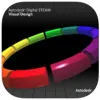Take a look inside 4 images
Autodesk Digital STEAM Visual Design
Pros: Multiple visual and text examples make terms easy to understand, and the app is free.
Cons: Missed opportunity for incorporating audio; no assessment included in app.
Bottom Line: Autodesk Digital STEAM Visual Design can be a good tool for individual, self-directed learning.
Use individual principles or elements for whole-class instruction or examples, or let individual students with an interest in visual design explore and learn self-directed. Use project-based learning to assess what kids have learned by having them demonstrate the principles and elements in their own design.
AUTODESK DIGITAL STEAM VISUAL DESIGN takes kids through elements and principles of visual design in the same 3-D design space used in design software. Each element or principle is defined and then shown visually. The Learn More section further explains the concept with text and images, giving how-to examples as well as real-world examples. The other apps in the Autodesk Digital STEAM curriculum include Measurement and Applied Mechanics and are designed to introduce kids to science, technology, engineering, arts, and math.
The list of elements and principles on the left of the screen serve as a table of contents. Kids can progress through each topic in order or tap the one they want to explore. They'll read a brief definition of the term and then see it and interact with it -- drawing a line, exploring forms in 3-D, or manipulating a color wheel, for example. They can then tap Learn More to read more in-depth information about the term.
This interactive textbook does a beautiful job of showing the principles of visual design, with written explanations that are easy to understand. The visual examples clearly demonstrate the principles and reinforce understanding. This isn't a game or creation tool, though. Kids will take what they learn here and use other design tools to put their new knowledge into practice.
Kids will learn about the design elements of space, points, lines, shapes, forms, value, texture, and color. They'll learn the design principles of balance, emphasis, rhythm, unity, proportion, contrast, continuation, and economy. Kids will also practice reading nonfiction texts for information. After reading the definitions, seeing a visual example of the principle or element, seeing and reading about how to implement it, and seeing examples of it in the real world and art, kids should have a good understanding of visual design fundamentals.













